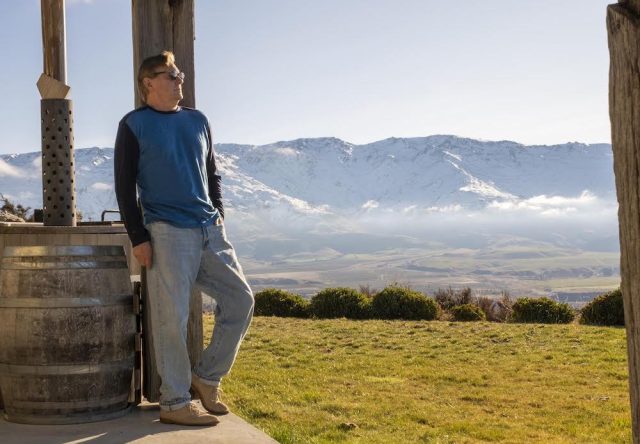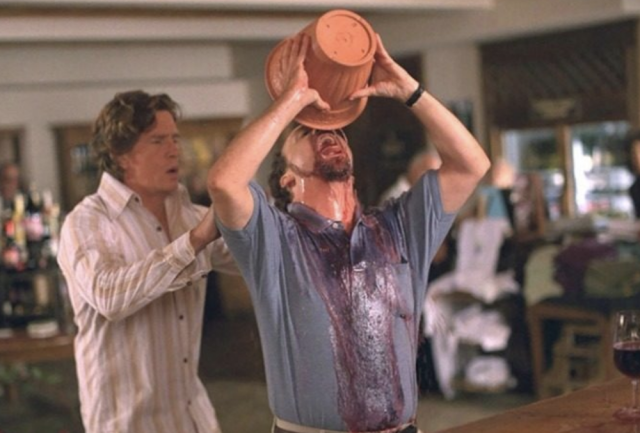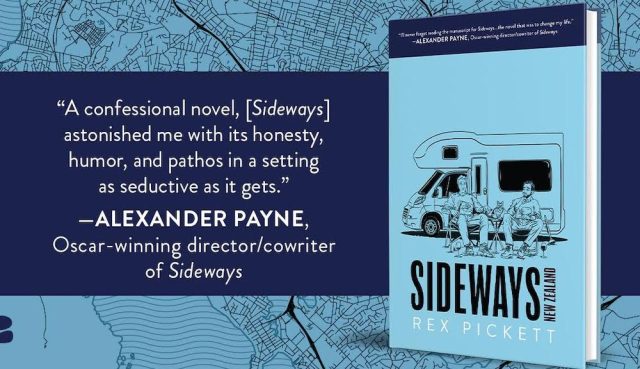本网站使用 Cookie,以便为您提供最佳的用户体验。Cookie 信息存储在您的浏览器中,其功能包括在您再次访问我们的网站时识别您的身份,以及帮助我们的团队了解您对网站的哪些部分最感兴趣和最有用。
雷克斯-皮克特:"葡萄酒不是一种民主
这位传奇的《Sideways》作者与酒水行业人士畅谈了他的新书、他对智利和新西兰葡萄酒的看法,当然还有黑比诺和梅洛。

对于近期黑比诺的增长和梅洛的衰退,葡萄酒界有一个众所周知的简称:"侧影效应"。在社交媒体和 "影响者 "时代到来之前,雷克斯-皮克特(Rex Pickett)的小说和亚历山大-佩恩(Alexander Payne)随后执导的电影产生了巨大的影响。
二十年后的今天,皮克特将回归原点。在一次独家专访中,皮克特告诉db,他目前正在撰写的新书《Sideways: 20》中,他在小说和电影中的人气角色和另一个自我迈尔斯-雷蒙德(Miles Raymond)将重返纳帕。在此过程中,他将重访那些曾孕育他作家和葡萄酒爱好者旅程的地方。
皮克特的故事也许是许多加利福尼亚未来作家和兜售剧本者的典型故事。他经历了多年的挣扎,随后在文学上获得认可,然后好莱坞导演选择了他的作品,他突然成名,并成为奥斯卡获奖影片的主角。尽管如此,他的成长历程远非一帆风顺,值得一提的是,当佩恩接手将这部小说改编成剧本时,这部小说仍未出版--这本身就是一个引人入胜的故事,皮克特曾对这个故事进行过详细阐述。
事实上,皮克特的叙述开始时,就像他告诉我们的那样,相当精彩,就像电影剧本中英雄之旅的开始:作为一个未发表过作品的作家,在加利福尼亚的一次品酒会上。他说,他 "对葡萄酒的一切了解 "都要归功于圣莫尼卡一家名为 Epicurus 的商店和商人 Julian Davies,尤其是 "臭名昭著的周六品酒会,在那里我了解了各种葡萄酒风格"。这是一个相当令人愉快的例子,说明了葡萄酒教育的力量,以及如何通过这些活动形成对某一主题的深厚热情。很难想象《侧耳倾听》不存在,皮克特对葡萄酒的热情也会胎死腹中,但如果他没有参加戴维斯的品酒会,也许这种情况就会发生。
影片的影响
后来,他在加利福尼亚沉沦,热爱葡萄酒,写下了这本改变他一生的书。
Sideway在葡萄酒行业的声誉主要体现在这部奥斯卡获奖影片的两个小节中,尽管整部影片和书确实主要围绕葡萄酒世界展开。其中一段只有几秒钟,另一段则有几分钟。在第一段中,主人公迈尔斯-雷蒙德(保罗-吉亚玛提饰演)--如前所述,是皮克特的 "另一个自我"--被他的朋友杰克(托马斯-哈登-丘奇饰演)拉到一家餐厅外,当时他们正与两位女士共进晚餐。此时,迈尔斯对喝梅洛酒进行了严厉的抨击。
皮克特那句臭名昭著的 "梅洛"(Merlot)并没有写进他的小说,而是在之前的草稿中发现的。导演亚历山大-佩恩(Alexander Payne)在资料档案中发现了这句台词--他在选择这部作品时收到了皮克特所有与《Sideways》相关的著作,包括之前的草稿和笔记--于是决定将其加入最终的剧本中。
影片中这一短暂瞬间的影响导致美国西部梅洛的销量下降了 2%。事实上,根据一些报道,"西德韦斯效应 "对该品种全球销售的影响至今仍在持续。
皮克特承认他不得不 "无数次 "回答关于梅洛葡萄的问题,他说:"有很多不同的答案"。这部电影之所以能流传至今,是因为演员保罗-吉亚玛提(Paul Giamatti)对葡萄品种的看法极具感染力。
"他说:"Merlot(梅洛)这句台词之所以能打动人,是因为它说得非常尖刻和谩骂。
但皮克特揭示的情况比乍一看的要复杂得多。他继续说道"让我给你一个不同的看法。如果你仔细观察这一幕,你就会明白到底发生了什么;杰克是想指导迈尔斯今晚的行动顺利进行,这样他就可以对未婚妻不忠。对于迈尔斯来说,在整部小说和电影中,这都不是他的首要任务。
"他的首要任务是出版他的小说,因为他觉得自己是个失败者。他斥责杰克,斥责杰克对未婚妻不忠。他是个道德家。所以杰克想指导他 迈尔斯整天都在品酒"
"杰克只是假定他认为梅洛葡萄酒等同于葡萄酒集权主义,这是我在90年代参加这些品酒会时的看法,也是《侧面》中小说的开篇:酒窖。但电影里没有"。
Plonk
皮克特还说,当人们找到他并知道佩恩加了那句臭名昭著的台词时,他很高兴,因为这意味着 "他们真的读过这本书"。
他继续说道:因此,梅洛成了廉价红葡萄酒的代名词,成了 "plonk",也成了葡萄酒 "philistinism "的代名词,至少在我所在的小组是这样。
这种对美乐的看法来自于在圣莫尼卡的生活,以及与那些对葡萄品种有着强烈看法的富人的交往。
"这是一个有趣的组合,"皮克特说,"我看到了葡萄酒世界的阶级主义、精英主义和势利主义。所有这些我都深恶痛绝。
他叹了口气,继续说道:"我真他妈的痛恨它。因此,梅洛酒就成了我的障碍。
皮克特继续说道:"迈尔斯基本上是在对杰克说,我今晚要成为一个通配符。所以当杰克指导他的时候,他的挫败感并不在梅洛身上,他的挫败感在杰克身上,他不想参加这次晚宴。
就是这样:迈尔斯并不是(真的)和梅洛有过节。他对他的朋友有意见。
品种
皮克特对其他葡萄品种的看法令人耳目一新,对其他葡萄的看法也毫不保留。也许这并不奇怪,因为他撰写了臭名昭著的梅洛葡萄酒系列。
他笑着说:"我并不是坐在那里只想讨论一种葡萄,"然后他补充道,"因为,你知道,我还可以提到其他葡萄。比如,我在基安蒂(Chianti)待了六个月,老实说,我很难找到我喜欢的桑娇维塞(Sangiovese)。但那是不同的故事,不同的国家。
皮克特还对 "侧影效应 "的影响以及它如何改变了葡萄酒世界表示遗憾。
他说:"受影响的是那些酿酒师,他们需要 10-15% 的梅洛来调配葡萄酒,以缓和赤霞珠的单宁酸,但市场上的梅洛不够。因此,他们更倾向于酿造 100% 赤霞珠葡萄酒"。
这可能是皮克特在隐晦地提及影片中的另一款梅洛葡萄酒--迈尔斯的那瓶1961年白马庄葡萄酒,它本身就是梅洛和品丽珠的混酿,在结尾的一幕中,他在快餐店里打开了这瓶酒,边吃汉堡边品尝了一口
有趣的是,霞多丽在影片中也受到了轻微的攻击,迈尔斯说它过于橡木味和奶油味。但这并没有影响到销售,当然也没有得到与梅洛系列相关的宣传。正如皮克特所说,这是在影片的一个缓和阶段说的,当时的紧张程度大大降低,场景 "就这样消失了"。
事实上,当我们向其他葡萄酒爱好者询问影片中的这一时刻时,很少有人记得迈尔斯对霞多丽的贬低比对梅洛的贬低更雄辩、更深思熟虑。即使在社交媒体和 "备忘录 "等现代文化尚未兴起的时候,人们对某一时刻的记忆就已经超越了其他时刻,这一点总是非常有趣。
黑比诺
与梅洛相对应的是所谓的 "侧向效应 "中的另一个关键角色:黑皮诺。
在一个可能是有史以来最精彩的以葡萄酒为主题的电影对白的场景中,迈尔斯和他的恋爱对象玛雅(弗吉尼亚-马德森的表演令人惊叹,曾获奥斯卡提名)讨论了皮诺和葡萄酒的一般情况。
正如皮克特所说,这一幕 "不言而喻",也许最好的办法就是观看下面这一幕,了解它所描绘的力量。现在来看,这部影片获得奥斯卡最佳改编剧本奖也就不足为奇了。
据葡萄酒行业分析师加布里埃尔-弗罗伊莫维奇(Gabriel Froymovich)称,自《侧面》上映以来,加州的黑皮诺产量增长了约 170%。如果说梅洛受到了电影的负面影响,那么迈尔斯对黑皮诺的诗意描述则导致了该品种的爆炸式增长。
但是,尽管取得了如此广泛的成功,似乎也出现了一个新问题:为什么尽管有这么多关于精心酿制的葡萄酒和手工生产的诗歌和言论,年轻人却不喜欢葡萄呢?去年,硅谷银行(Silicon Valley Bank)报告称,在 65 岁以上的消费者中,有 58% 的人喜欢葡萄酒而非其他酒精饮料,但在千禧一代和 Z 世代中,这一比例仅为四分之一。
皮克特认为,问题出在消费者对葡萄酒的态度上,归根结底是饮酒者认为什么是最重要的。
他继续说道:"真正的问题在于葡萄酒的美感和诗意。一旦你开始酿造年份酒,我认为你就失去了葡萄酒的诗意。
质量

这就是年轻人少喝葡萄酒的原因吗?Pickett 认为,酿酒师需要大肆宣扬葡萄酒的年份和品质,而不是其他饮品,并坦诚面对葡萄酒在消费者购买层次中的地位。
他说:"价格低廉的葡萄酒品质并不高。当我们谈论年份酒,谈论葡萄酒令人难以置信的产量和艺术性时,这就是人们爱上它的原因。
"但这不是真的"
皮克特解释说,当他获得有关木桶的知识时,这是一堂很有启发性的课。他说:"大约一年前,我做了一篇关于木桶的文章,他们让我主持。我发现只有 4% 的葡萄酒能见到木桶。因此,我们谈论的大多是真正商业化、工业化的葡萄酒。
"我不想这么说,因为我也不是有钱人,但因为我从事的是葡萄酒生意,所以我也有份。人们给我送酒。我觉得皮诺葡萄酒甚至要到 30 美元才开始卖。在30美元以下,我喝过一些25美元和20美元的皮诺葡萄酒,它们都不错,但还没有开始真正表现葡萄的特点。
"只有当人们可以使用木桶、篮式压榨机和重力流等设备时,才能真正展示出它的神奇和潜力"。
在价格方面,Pickett 举例说明了他目前最喜欢的葡萄酒--索诺玛的 Ancien 葡萄酒。
他继续说道:"这是我最喜欢的餐厅之一,我刚刚在博客上介绍了餐厅老板肯-伯纳德,他做的一切都是对的。但他不是为了钱。很明显,他是出于热爱。当然,我相信他也想赚钱。但他酿造的葡萄酒,一瓶要 50 到 70 美元。实话告诉你吧,它们的价值超过 100 美元一瓶,但他拿不到。"
皮克特停顿了一下,总结道:"归根结底,你看重的是生活中的什么。我看到有人给自己的卡车加油,每加仑能跑 8 英里。这是他们的首要任务。但我的首要任务是喝葡萄酒。一旦你对葡萄酒达到了一定的境界,你就很难再去喝 15 美元或 20 美元一瓶的皮诺葡萄酒了。
文学
虽然将葡萄酒的 "艺术 "与其价值相提并论可能会被认为是精英主义,但皮克特认为,生产商应该像其他奢侈品和技术产品制造商一样,重视其产品的价值。
"我想这有点像文学或电影,"他继续说,"一旦你形成了审美感受,就很难再读那种翻来覆去的东西了。你已经形成了一种感性。
"这也是葡萄酒吸引我的原因之一,因为它确实与文学和电影有相似之处。现在很难再回到价格较低的葡萄酒上来吸引年轻观众了。
但 Pickett 承认,这是一项挑战,消费者必须面对葡萄酒世界的复杂性及其成本。
他继续说道:"我认为,吸引他们的是他们真正品尝到最顶级的葡萄酒。但是,包括我在内,没有人能够品尝到勃艮第葡萄酒。
"你的味觉已经开发出来了,你必须能够品尝这些酒。我知道我在《侧面》里写过这些酒,但我没喝过。我有幸在这里认识了一些人,他们有机会品尝到这些葡萄酒,他们邀请我去参加一些活动,我喝到了这些空灵、不可思议的葡萄酒,但我知道它们一瓶要 200-500 美元。
"我买不起,你知道的。比如说,文学或电影就不一样,我不是想扯远了......但葡萄酒不是民主"。
"无论你是谁,你都可以阅读《战争与和平》。你可以看《阿拉伯的劳伦斯》或伟大的电影。但你们不能都喝DRC"
他停顿了一下,考虑着自己的答案:"所以我不太确定答案是什么,因为我认为如果他们开始偷工减料,使用葡萄酒,我遇到过很多酿酒师,要酿造出真正好的葡萄酒,真正表达出葡萄和风土......这需要花钱。
另一个 侧影

皮克特也许还在经常回答有关《侧翼》原著和电影的问题,但他在过去的 20 年里并没有停滞不前。
他创作了大量关于他的另一个自我迈尔斯的作品,在他最新的小说将他带回加利福尼亚之前,他在世界各地的其他葡萄酒产区进行了各种冒险,包括俄勒冈、智利和新西兰。
Pickett 解释了他的第二本书如何通过新的出版商 Blackstone 以《Sideways:俄勒冈州》,由他的新出版商 Blackstone 重新出版。现在,所有《Sideways》小说都以精美的精装本形式呈现,这也是原版小说首次采用这种形式。
"今年 10 月是电影《Sideways》的 20 周年纪念,所以我决定把我所有的书都出版一遍。我很高兴《Sideways:俄勒冈》将重新发行,因为很多人认为这是四部小说中最好的一部。这是一个非常凄美的故事。
侧面俄勒冈州
他讲述了读者如何经常将这些文本视为 "公路电影 "或 "公路小说"。非常明显的是,皮克特确实把迈尔斯-雷蒙德看作是自己的变体,他在写作之前先到各地考察,融入当地的文化,了解当地的生产者,从而 "找到故事"。
谈到《俄勒冈》,他说:"这是一次 4000 英里的公路旅行。严格来说,《Sideways》并不是一部公路电影,实际上我称之为'旅居电影',因为他们去了一个地方,然后把屁股停在那里。
因此,这些小说都是根据生活经验创作的,皮克特亲自走访葡萄园和生产商。皮克特将葡萄酒置于文本的中心,将葡萄酒艺术与生活体验明确地联系在一起。
侧身智利
在《Sideways:在《Sideways:智利》节目中,皮克特采用了一种略微不同的方式,他作为智利葡萄酒组织和专业智利组织的客人到访,这两个组织向他提出了一个概念:"为什么不把迈尔斯和杰克带到这里来呢?
他说,虽然他理解这些团体希望有一个创造性的作品,从而 "收获圣塔伊内兹山谷的利益",但他也在 "努力寻找一个故事",并且必须 "找到人物"。
皮克特解释说,他 "参加了巡回演出",但 "对我来说并不合适",就像迈尔斯一样,他必须 "自己去发现和突破"。为了在智利葡萄酒界找到自己的位置,皮克特参加了名为 "MOVI "的独立葡萄酒生产商运动,尤其是德里克-莫斯曼(Derek Mossman)的车库葡萄酒公司(Garage Wine Co.
他继续说道:"我在智利稍作突破,开始发现 MOVI,即独立葡萄酒商运动。
"我遇到了德里克-莫斯曼(Derek Mossman)和其他一些人,他们给了我很大的帮助。我认识了这些真正的独立酿酒师。我总是对小规模的酿酒商感兴趣,他们是为了对葡萄酒的热爱而酿酒。他们并不是真的为了钱"。
通过这段经历,他还发现了其他一些酿酒师,其中包括一位他特别喜欢的酿酒师。
"他继续说道:"我发现了 Viña Casa Marin 的酒庄。他继续说道,"这是一个令人难以置信的葡萄酒故事。那里有一位女酿酒师 María Luz Marin,她在卡萨布兰卡山谷酿造的葡萄酒让人欲罢不能。
"但我发现,当你走到圣地亚哥南部 人们谈论迈坡谷的时候" "那里的游客非常多"
至于皮诺葡萄酒,他喜欢圣安东尼奥的 Casa Marin、莱达的 Garces Silva's Amayna 和卡萨布兰卡的 Casas del Bosque。
他解释说:"他们正在用某些原生葡萄做一些事情","这正是我感兴趣的地方,那就是发现那些往往处于边缘地带的小人物"。
他顿了顿,又补充道:"我对大的不感兴趣,大的也知道我喜欢这样,也尊重这样"。
我们可以看到,这是皮克特关注的核心问题。对他来说,葡萄酒不仅仅是一种大规模生产饮料的制造工艺。它远不止于此。而且,并不总是小生产商在做令人兴奋的事情。
他说:"我知道 50%的葡萄酒都是名酒。但钱并不总是坏事。钱可以让(生产商)开展实验项目,尝试其他东西。
"一些小型酿酒商没有钱去尝试生物动力或篮式压榨机以及其他可能是最前沿的东西"。
侧身新西兰
那么,他的另一部作品《Sideways》的内核是什么?新西兰》?正如皮克特的创作过程一样,这本书对于迈尔斯和杰克来说从来都不是一个简单的过程。
他继续说道:"新西兰的压力较小。实际上压力更小,因为他们的资金来源不同。
"与智利相比,他们主要是在基础设施方面帮助我。在新西兰,这不是一个合同问题,更像是你要帮我找到这些地方,所以我很快就发现了南岛南部的中奥塔哥。
在谈到他最喜欢的品种时,他露出了笑容:"是的,80%的黑皮诺都是在这种土壤中种植的,这种土壤有 3% 的有机质,而且是非常非常坚硬的片岩土壤。在这样的土壤里几乎连杂草都长不出来。所以我对世界边缘的葡萄酒很感兴趣。
"但还有一个故事。我想出了一个故事 迈尔斯在那里做什么?已经过了10年了 所以我开始想 也许他已经离开了已知世界
"他和我一样,过着漂泊不定的生活。这并不全是自传,显然也有虚构的成分,但我在作品中融入了很多自己的东西,我认为这才是作品的真实性所在。"
"他写了一本书,准备去巡回售书,还找到了出版商。但出版商给了他一个诱饵不是真正意义上的巡回售书而是让他们和杰克一起住在露营车里我就是这么做的 野营车和书友会
"这真是一次难忘的经历。新西兰是新西兰给我的一本书"。
商业方面
回到新西兰葡萄酒的话题,Pickett 谈到了新西兰最著名的出口产品。
"他继续说道:"新西兰也有其商业化的一面,67%的白苏文翁葡萄酒都是在新西兰生产的,其中很大一部分直接进入了金-克劳馥(Kim Crawford)和维拉玛丽亚(Villa Maria)的市场。他们酿制配方葡萄酒,仅在美国就销售了一百万箱。他们在工厂里酿酒。他们为亚洲市场酿造葡萄酒,为英国市场酿造甜度和酸度不同的葡萄酒。
他停顿了一下,"我有很多问题。对我来说,这不是葡萄酒的真谛"。
"这一切可能都要归功于 90 年代的 Cloudy Bay。他们酿造出了某种味道,我不知道,但我猜人们称之为'青草绿'。这是一种柠檬味的长相思白葡萄酒,老实说,他们只是把它商品化了。
但皮克特解释说,他在旅途中确实遇到了许多小酿酒商。
他继续说道:"我遇到了伊顿葡萄酒公司的迈克-伊顿(Mike Eaton)。其中有些人只有一桶长相思塞米利翁葡萄酒,他们正在尝试做不同的事情。
另一个让皮克特钦佩的酒庄是 "稍大一点 "的飞马湾酒庄,他说,"他们正在做一些非常有趣的事情"。
返回家园
回到《 Sideways: 20》,Pickett 强调了新西兰和加利福尼亚的相似之处。"他说:"纳帕和索诺玛也是一样,这里有很多大酒厂。他们以自己的名字酿酒。他们是靠名声起家的。
"但在某种程度上,他们也在酿造配方酒。他们会在设备中使用添加剂,使用离心机,这在业内是众所周知的。
"那里还有一些人,比如肯-伯纳德、朱利安-法亚尔和其他一些小型酿酒师。当然,还有安德森谷。他们都还在努力成为纯粹主义者。
他最后说"这些都是我所向往的人"。

